Abstract
The Eszterháza Opera House was a theatre built by the will of the Hungarian Prince Nikolaus Esterházy in the second half of the 18th century that had to compete in greatness and grandeur against Austrian Empire. The composer that inextricably linked his name to this theatre was Haydn that served the prince and composed pieces for him for many years. The Opera House disappeared from the palace complex maps around 1865 and was destroyed permanently during the Second World War. This study aims to reconstruct the original shape and materials of the theatre, thanks to the documents founded by researchers in the library of the Esterházy family at Forchtenstein, the Hungarian National Library, and analyze its acoustic behavior. With the 3D model of the theatre, acoustic simulations were performed using the architectural acoustic software Ramsete to understand its acoustical characteristics and if the architecture of the Eszterháza Opera House could favor the Prince’s listening. The obtained results show that the union between the large volume of the theatre and the reflective materials makes the Opera House a reverberant space. The acoustic parameters are considered acoustically favorable both for the music and for the speech transmission too. Moreover, the results confirm that the geometry and the shape of the Eszterháza Opera House favored the Prince’s view and listening, amplifying onstage voices and focusing the sound into his box.
1. Introduction
The research on the acoustic characteristic of historical buildings is becoming more and more frequently a theme on which researchers focus their attention, because acoustic is more often considered a cultural heritage and an important feature of several ancient important buildings such as Opera House [1,2,3,4,5].
To analyze the sound field of Opera House, in situ measurements are performed, placing a lot of receivers in the hall and some sound sources on stage and orchestra pit [6,7] and recording monaural and binaural impulse responses (RIRs). Finally, measured impulse responses are used for the calculation of the room acoustic parameters. Unfortunately, a lot of public and private theatres and their intangible cultural heritage, i.e., the acoustics, were devastated and demolished during past fires, wars, and natural disasters [8,9,10], such as for Eszterháza Opera House, a theatre built by Prince Nikolaus I Esterházy was destroyed during the Second World War. For this reason, computer simulation became an essential tool for the reconstruction of the acoustic field of ancient and destroyed theatres. The creation of a virtual acoustic model of a theatre allows to generate a signal and process the impulse response, from which it is possible to analyze the acoustic features and acoustic parameters of the reconstructed historical building.
The 3D model of the historical Eszterháza Opera House was realized to rediscover the acoustics of this theatre and to analyze the position occupied by Prince Nikolaus I Esterházy during performances.
The second section illustrates a brief history of Eszterháza Opera House reporting some figures and drawings of the original shape. The third section explains the assumptions considered during the development of the 3D model and scenarios. Finally, the results and conclusions are discussed in the last paragraphs.
2. The History of Eszterháza Opera House
Eszterháza is a palace located in Fertőd town, a location in northwestern Hungary born from the union of two towns Eszterháza and Süttöra in 1950. The palace was built in Rococò style and was called the Hungarian Versailles. In 1720, Prince Nikolaus Esterházy was used to spend much of his time in a hunting lodge called Süttör, which was designed by Anton Erhard Martinelli.
In 1768, the Prince permanently settled in the hunting lodge that was renamed “Eszterháza” and become the nucleus around which Eszterháza Palace was built. In 1763, Nikolaus Esterházy started the construction of the palace, including the Opera House, which had to compete in greatness and grandeur against the Austrian imperial residences. The Prince entrusted the construction of the palace to the architect Melchior Hefele, and the new palace had to be an extension of a pre-existing hunting lodge. Since 1768, the construction of the first Opera House was completed and many musical entertainments were performed. However, the Opera House burned down in November 1779 and was replaced by a second Opera House, and the construction of the second theatre continued from 1779 to February 1781 [11] (Figure 1).
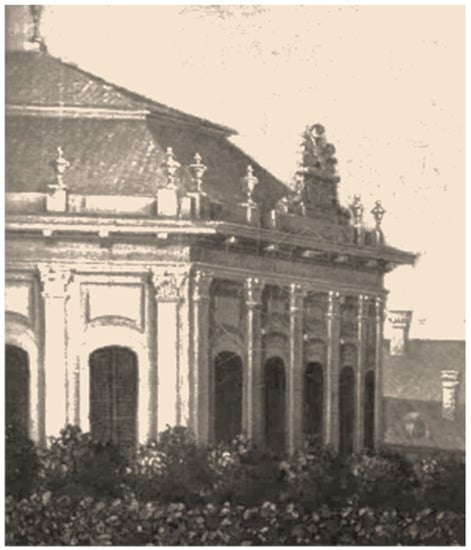
Figure 1.
Drawing of the second Eszterháza Opera House. Enlarged detail of Antonio Pesci’s painting depicting the south facade of the palace–Modified (Építészeti Múzeum—Museum of Architecture, Budapest).
The new, reconstructed Opera House was inaugurated with the performance of Haydn, La fedeltà premiata. The construction phases of the second Opera House and the materials used for its realization were tidily registered by the Esterházy administration. A document entitled “Extent of the masonry work regarding the new playhouse” of the court engineer Michael Stöger confirms that the new theatre was built on the site that had been previously occupied by the first Opera House. Prince Nikolaus ordered that the second theatre had to be very similar in dimensions to Schönbrunn theatre. From the examination of the drawings of the Opera House dated 1784 (Figure 2) and recent pictures of the Schönbrunn theatre (Figure 3), one can discover that some of the main characteristics of the current layout of Schönbrunn’s interior resemble the historical plan of Eszterháza: the oval hall with a raised gallery on three sides, in which the central section, opposite to the stage, was reserved to the Price family. The Royal box was supported by stone columns and covered by a canopy and surrounded by two side-boxes. At Eszterháza Opera House, the Royal box was connected with the galleries and with such an arrangement, the Prince could leave his Royal box and visit his visitors and his court sitting anywhere on the gallery level. The main difference between the two theatres is that the Eszterháza Opera House was an independent building and it was connected to the main palace by only a short walk through the ornamental garden, whereas the theatre of Schönbrunn was built into a wing of the palace.
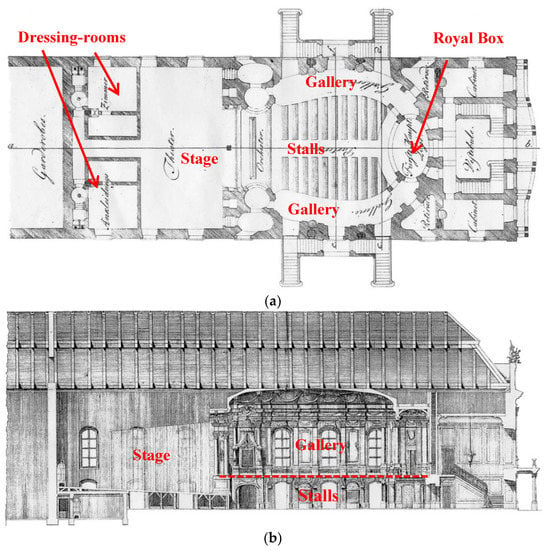
Figure 2.
Drawings of Eszterháza Opera House in 1784: (a) plan of the theatre and (b) longitudinal section of the theatre–Modified [12].
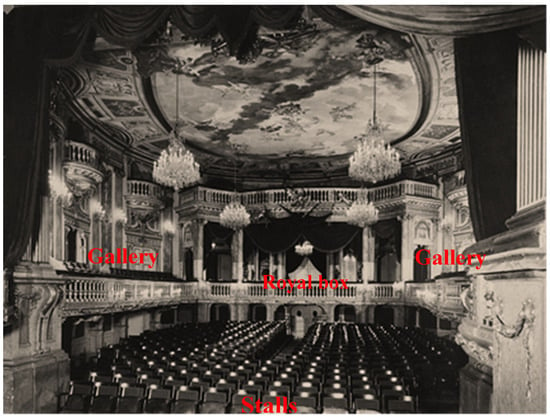
Figure 3.
Recent picture of the Schönbrunn Theatre–Modified (copyright: Schloϐ Schönbrunn Kultur-und Betriebsges.m.b.H).
Prince Esterházy allowed commoners to join his noble guests at performances at Eszterháza, but with this arrangement of the theatre, Eszterháza Opera House could maintain the old order of social separation among his guests. The composer Haydn served Prince Nikolaus I from 1762, and between 1766 and 1790, the palace housed him as the composer of the prince, and he wrote the majority of his symphonies for the Prince’s orchestra. The regular opera seasons at the Eszterháza “opera factory” were first established in 1776, and the majority of Haydn’s opera productions were connected with the second opera house in the period from 1781 to 1790. The prince demanded two operas and two concerts every week, as well as chamber music every hour. The prince personally enjoyed playing the baryton (Viola di Bordone), for which Haydn created 175 compositions. The Opera House had several distinct features, such as a seat for the prince who had the best view, and the orchestra sat in front of the stage; there was no space for a conductor. The first performance of Joseph Haydn played in the Opera House was Lo speziale in 1768, followed by Le pescatrici in 1769 [13,14,15]. After Nikolaus’ death in 1790, none of the heirs wanted to live in Esterháza, and the theatre fell into disrepair and eventually disappeared from the palace complex maps around 1865. During the Second World War, the theatre was definitively destroyed, while the Palace has recently been restored, returning to its former glory (Figure 4).
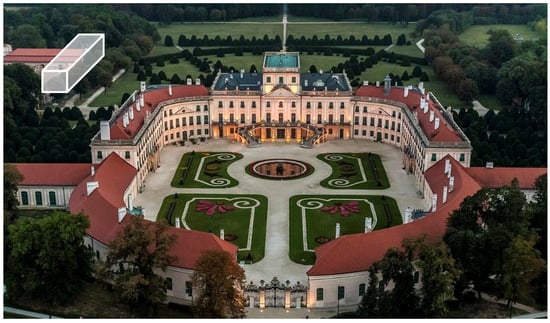
Figure 4.
View of restored Esterházy Palace [16]-Modified. The position of the Eszterháza Opera House is indicated with the white box.
The main documents founded by researchers for updating the image of the Eszterháza Opera House derive from the Esterházy family library at Forchtenstein, the Hungarian National Library, and the materials consist of site plans, descriptions, inventories, cost estimates, administration decisions, and invoices concerning the construction process and materials. From the study of drawings, it becomes clear that the geometry and shape of the Eszterháza Opera House favored the position of the prince in every aspect. In fact, he enjoyed the ideal illusion of central perspective because his eyes were almost at the level with the vanishing point defined by the slope of the stage.
3. Model of the Eszterháza Opera House for Geometrical Acoustic Simulations
3.1. The 3D Model of the Eszterháza Opera House
The 3D model of the theatre was realized to reconstruct the acoustics of the Eszterháza Opera House, starting from the analysis of available literature and drawings dated 1784 and 1789 (Figure 2 and Figure 5). The two figures present an architectural discrepancy in the different positioning of the lateral access stairs. Consequently, the most detailed version of the plan (Figure 5) was used to create the base for the 3D model. Subsequently, the ground was integrated with the longitudinal section of the theatre (Figure 2b).
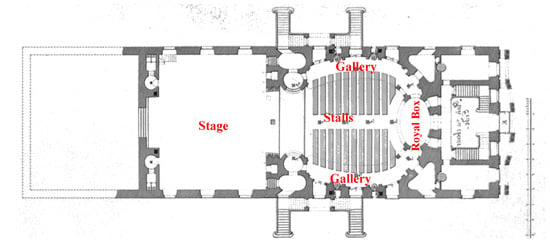
Figure 5.
Plan of the theatre made by the master builder Joseph Ringer in 1789 from the National Archives-Modified (Országos Levéltár, OL T2 no. 1222, Budapest).
A geometrical model including 2175 surfaces (3D Faces), 3420 m2 surface area, and 5659 m3 volume was realized in AutoCAD software, according to guidelines of previous literature [17]. During the phase of drawing of the model, the images were scaled according to the “klafter” measurement unit present in the respective documents. The “klafter” is a historical unit of length, volume, and the area used in Central Europe, 1 Klafter = 18.965 m. To perform the simulations, a simplified 3D CAD model of the Opera House was created (Figure 6).
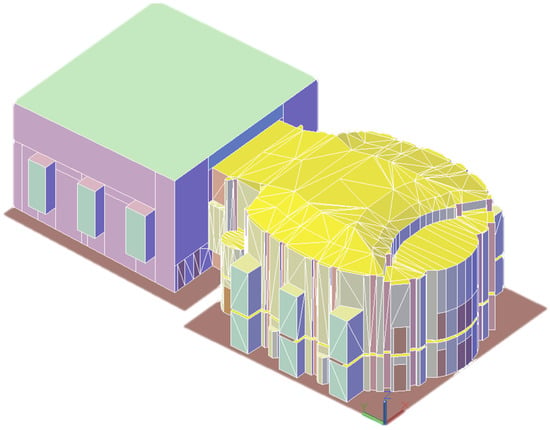
Figure 6.
The 3D model of the Eszterháza Opera House.
Very detailed 3D models are known to considerably increase computation time without improving results accuracy [18]. Consequently, the theatre was modelled by representing only the geometrical shape and significant elements, while surfaces having rich decorative patterns were simulated as flat planes. Therefore, during the realization of the model employing 3D faces, all those curved surfaces, such as the arched openings, the handrail, and portions of the slabs, have been approximated with polylines to create complex surfaces. The purpose was to obtain a model that was as close as possible to reality but at the same time to not take into account those elements that produce a minimal or irrelevant variation in terms of physical parameters. The AutoCAD layers were managed considering used construction materials (12 layers in total) because the architectural acoustic software is based on the response produced by the different materials in terms of absorption and scattering coefficients. Consequently, a material and coefficient were assigned to all the surfaces of the model through hypotheses formulated by visual inspection of the historical images: window frame, floor, wall, backrest chair, seat chairs, ceiling, curtains, and chandeliers. Subsequently, the 3D CAD model was exported in .dxf format and three acoustic simulations were performed to analyze the acoustic behavior of the theatre using the architectural acoustic software Ramsete [19,20]. Thanks to this software, it was possible to acquire acoustics parameters necessary to investigate the acoustic characteristics of the simulated theatre.
3.2. Assumptions and Acoustic Simulations
In this study, the calibration of the model was not conducted, because the original Opera House was destroyed during the Second War World and, currently, it is possible to visit an auditorium that differs considerably from the original theatre. Consequently, to assign material properties, some consideration about the materiality of the original theatre was necessary. The absorption and scattering coefficients were attributed considering usual values from the literature [21,22], possibly combining them with those resulting from research on acoustic simulations of similar buildings [23]. Researches and some historical documents [11] confirm the similarity of Eszterháza Opera House with the Schönbrunn Theatre.
The exterior walls of the building were considered made by masonry, while the interior of the hall was lined with a variety of materials including plaster along the walls and wooden parquet on the floors. The parapet of the balcony and the columns on walls were made by hard stone, whereas the timber ceiling structure supported painted plaster work in the main hall. Moreover, French windows were lined up along the gallery.
Once defined the materials of the theatre, the absorption and scattering coefficients were selected from the database accordingly with the values employed during the acoustic virtual reconstruction of the Theatre Ideale by Francesco Milizia and considering usual literature values [23,24,25]. Consequently, the defined materials and their absorption and scattering (s) coefficients were reported on a specific file as in Table 1. For the audience, the values are higher than in other cases, since in that time, the spectators used to wear full skirts and wigs.

Table 1.
Absorption and scattering coefficients (s) for all the materials involved in the simulation. The scattering coefficient is referred to 707 Hz.
Two omnidirectional sources (A and B) were placed on the stage and the 106 receivers were uniformly distributed throughout the stalls and balcony (from R1 to R85 in the stalls and from R86 to R106 in the balcony), see Figure 7. The signals were simultaneously emitted from the stage to simulate the performance of actors and musicians. Then, the architectural acoustic software made the energetic sum of the impulse response A and B. Once the total IR was obtained, the acoustic parameters were calculated.
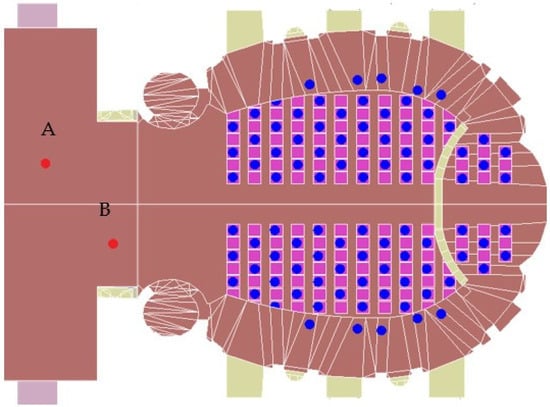
Figure 7.
Plan of sound source positions (red points) and 106 receiver positions (blue points).
Once the model was validated for the empty theatre (Scenario 1, as Figure 8a), the absorption coefficient of the chairs was modified to simulate the presence of the audience in the hall (Scenario 2). The value of absorption coefficients of the chairs has been replaced with tissue’s coefficient, as done in the previous study, that achieved excellent results [26]. The presence of the audience in the stalls, galleries, and Royal box is important to understand whether it can negatively affect the overall acoustics of the theatre and if it involves variations of the room’s acoustics parameters. The sound absorption of the spectators depends on posture, clothing, and also occupation density [27,28,29] and its value was chosen accordingly with the literature [23]. From the analysis of historical references [11,12,13,14,15,16], it is possible to state that Eszterháza Opera House had many capacities in its historical evolution, and it was not normally used in full capacity, and indeed, the chairs were not always placed in the galleries. Therefore, the simulations were performed placing about 200 chairs in the main hall.
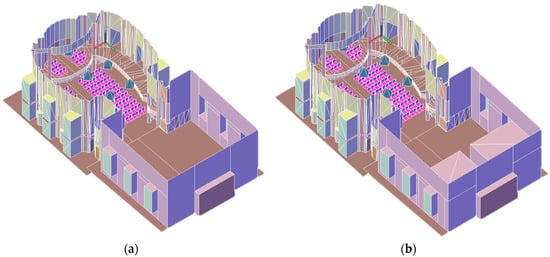
Figure 8.
The 3D model of the Eszterháza Opera House in Scenarios 1 and 2 (a), and the 3D model of the Eszterháza Opera House in Scenario 3 (b).
In the last simulation, Eszterháza Opera House 3D model was reconstructed according to the plan dated 1784 (Figure 8b), adding two dressing rooms (6.50 m high, 7.40 m wide, and 5.80 m long) covered with lime plaster at the back of the stage without the presence of the audience in the main hall (Scenario 3).
Acoustic simulations were carried out in the octave bands from 250 to 4 kHz, setting the relative humidity at 50% and temperature at 20 Celsius. The IR definition was set 1 ms with the length of 5 s. The main acoustic parameters defined in ISO 3382-1:2009 [30] were calculated, and the results of the simulations are discussed. The reverberation was evaluated through reverberation time (T10 and T30), while the perceived reverberation was obtained with Early Decay Time (EDT). The clarity perceived for music was related to the parameter C80, whereas the clarity perceived for the speech was related to the parameter C50. Moreover, the center time, strength, and STI (Speech transmission index) were calculated.
4. Results and Discussion
Figure 9 and Figure 10 report the results of several monaural parameters obtained with the two sound sources on the stage for the theatre in Scenario 1, Scenario 2, and Scenario 3. First, the effect of occupancy on the acoustical parameters was investigated. The reverberation time was analyzed, and it appears that Eszterháza Opera House, with its great volume and highly reflective materials, favors high reverberation times at mid-frequency. Slightly lower differences between unoccupied and occupied theatre appeared for EDT and T10 possibly as a consequence of the big air volume and the contribution of unchanged early reflections, whereas in Scenario 3, the theatre was less reverberant than the others due to smaller air volume.
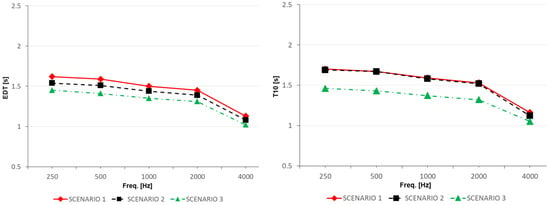
Figure 9.
Averaged values of the simulated acoustic parameters (Early Decay Time (EDT) and T10) for the theatre in Scenario 1 (empty theatre), Scenario 2 (with the audience), and Scenario 3 (3D model reconstructed according to the plan dated 1784 in unoccupied condition).
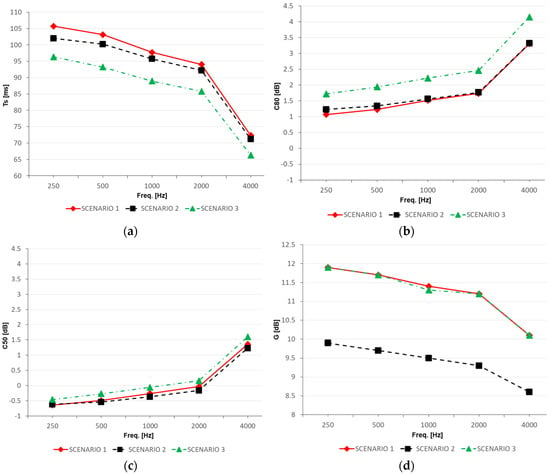
Figure 10.
Averaged values of the simulated acoustic parameters (a) Ts, (b) C80, (c) C50, and (d) G for the theatre in Scenario 1 (empty theatre), Scenario 2 (with the audience), and Scenario 3 (3D model reconstructed according to the plan dated 1784 in unoccupied condition).
The acoustic characteristic of the Opera House in terms of music perception is important since Haydn’s symphonies and chamber music was listened by Prince Nikolaus I.
As can be seen from the graphs, the center time spans from 88 ms (with dressing rooms on the stage) to 97 ms (without the audience) at 1 kHz, while the parameter C80 assumes values between 1.5 dB (without the audience) and 2.3 dB (with dressing rooms on the stage) at mid-frequencies and therefore, the presence of the audience and the dressing rooms on the stage cause small changes in terms of music perception. The parameter C80 shows that the theatre dated 1784 had a better desirable condition for musical performances.
The clarity C50 in all configurations results about 0.2 dB at 1000 Hz, which corresponds to quite good conditions for speech listening, as found in other theatres [31]. The analysis then considered the sound strength (G), and the results show that the dressing rooms on the stage have no effect over the sound strength values in Scenario 1. Conversely, the presence of the audience in the hall significantly changes the results of the sound strength.
Figure 11 reports the maps of the T30, C80, and STI in Scenario 1 (unoccupied condition). The maps give the following indications: the reverberation time is around 1.55 s in the Royal box in front of the stage and seems that, in this area, the T30 remains almost uniform as if the sound was perfectly diffused. The reverberation time values vary from around 1.59 s in the stalls near the Prince’s box to around 1.68 s near the stage.
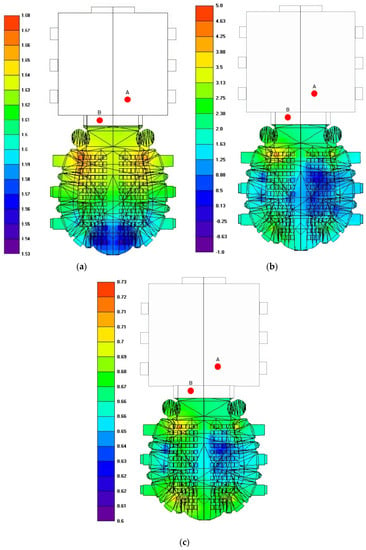
Figure 11.
Color maps at 1 kHz of the T30 (a), C80 (b), and Speech Transmission Index (STI) (c) in unoccupied condition and with asymmetrical positions of the sound sources A and B on the stage.
At the frequency of 1 kHz, the parameter C80 results around 1.65 dB in the Royal box, confirming the uniformity of the perception in all the positions reserved for the prince. However, the situation in the stalls and galleries differs significantly, in fact, it is interesting to notice that the positions in the right side of audience area and the left galley have clarity values around 0 dB, whereas in the other parts of the hall the values are above 1.6 dB.
Finally, in order to assess speech intelligibility, the Speech Transmission Index (STI) was considered. The parameter results are in the good range (the values span from 0.6 to 0.7). Anyway, in the stalls and galleries, focalization phenomenon seems to be forming but it is due to the different position of the sound sources A and B on the stage. In fact, the different placement of sound sources results in a nonsymmetric distribution of some acoustic parameters, and this behavior is more marked for clarity and STI values, while the prince’s box has an excellent sound diffusion and the values are well distributed.
The binaural room impulse response was obtained to study the phenomenon of spatial impression in the theatre. Binaural room impulse responses (BRIRs) are calculated using the directivity of omnidirectional decahedron and head-related transfer function (HRTF) of virtual receivers, according to the state-of-the-art of the room simulations [32]. The simulations of the binaural IRs were performed for five relevant receiver positions in the main hall and with the two sound sources A and B on the stage with theatre in the empty configuration.
In Figure 12, the result of the early interaural cross-correlation coefficient (IACC) is presented. In this plotted graph, it can be noted that IACC presents quite high values at low and medium frequencies, and this provides a fair immersive listening experience to people.

Figure 12.
Averaged values of the interaural cross-correlation coefficient (IACC) simulated in five relevant receiver positions in the hall without audience.
Figure 13 reports a comparison between the results of acoustic simulations with the audience, averaged for each sound source over three groups of receivers: stalls, Prince’s box, and galleries (Figure 14).
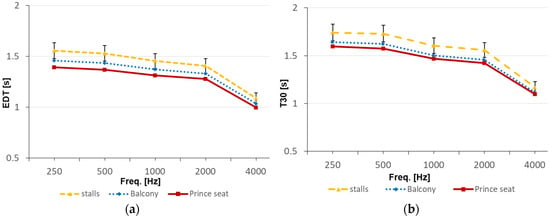
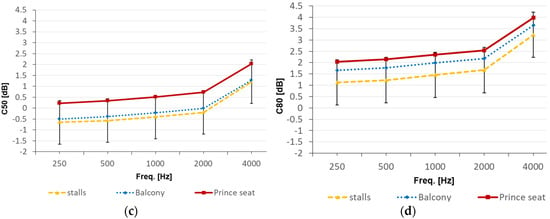
Figure 13.
Simulated acoustic parameters ((a) EDT, (b) T30, (c) C50, and (d) C80) for the theatre with the audience in the main hall. The values are subdivided into three groups (stalls, Prince’s box, and gallery) and averaged over the corresponding receivers. The error bars (Just Noticeable Difference, JND) are reported for receivers in the stalls.
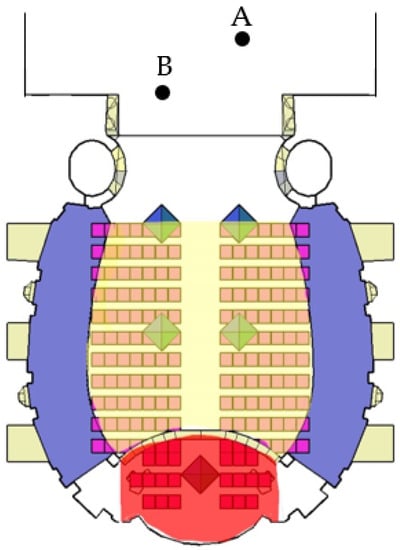
Figure 14.
Plan of the theatre with the three groups of receivers: stalls in yellow, gallery in blue, and Prince’s box in red.
Figure 13 reports the graphs of the most relevant acoustic parameters here considered. For sake of simplicity, the analysis of the Just Noticeable Difference (JND) is reported only for the stalls, where the majority of the receivers are located. The comparison shows that for EDT and T30, differences fall within the limit of the JND range (5%) for the receivers in the galleries, whereas the simulated results in the Prince’s box are slightly lower than those simulated in the galleries and outside the JND range of the stalls.
These results indicate that the reverberation is uniformly perceived in the stalls and gallery, whereas the Royal box is slightly less reverberant. This enhancement in reverberation brings greater results in terms of musical clarity and speech listening compared to the results in other positions so the prince could appreciate the balance between the voice and the orchestra. The C50 and C80 graphs show that the variability of the parameters is included in the JND range (1 dB).
Moreover, the study of the separate results for the two sound sources A and B on the stage is reported in Figure 15.
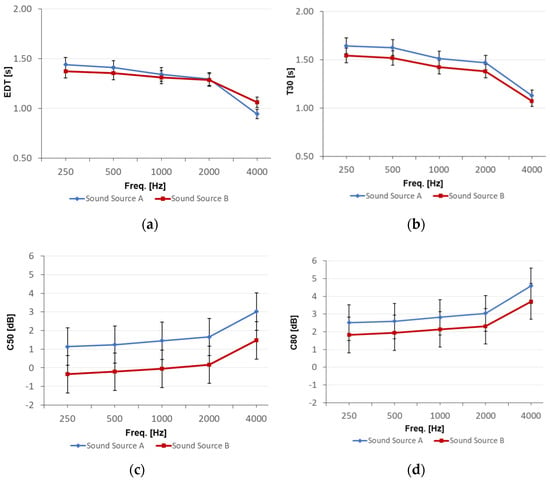
Figure 15.
Comparison of the average acoustic parameters ((a) EDT, (b)T30, (c) C50, and (d) C80) simulated with receivers and audience in the Prince’s box and the two sound sources A and B on the stage. The error bars (Just Noticeable Difference, JND) are reported for EDT and T30 (5%) and for clarity (1 dB).
The acoustic parameters were calculated only for the receivers in the Royal box and with the presence of the audience. Changes in reverberation are very small, especially for the early decay time parameter, where the differences between the two sound sources fall within the limit of the JND range (5%) and the early reflections are slightly perceived. Moreover, the T30 graph shows that the variability of the parameter is included in the JND range (5%) and there isn’t a relevant difference between the perception of the late reflections produced by the sound source A and by the sound source B.
Conversely, the position of the source on the stage influences much more the speech and music perception in the Prince box. Especially, the C50 graph shows that the values with the sound source in A and B fall within the limit of the JND range (5%) and speech listening with the sound source in A is better than position B. While the music listening in the Royal box does not seem to be influenced by the position of the sound source.
5. Conclusions
This paper has described the acoustic behavior of Eszterháza Opera House, a private theatre built according to the Hungarian Prince Nikolaus Esterházy’s wish. The results obtained from the elaboration of the virtual model showed that the quite large volume of the theatre together with the reflective finishing materials used in its interior make the Opera House a reverberant space. The reverberation time value of the theatre is acoustically favorable both for the music and for the word transmission, and it was suitable, however, for higher ranks who attended chamber music and operas of the celebrated composer Joseph Haydn. Furthermore, the numerical simulation analysis shows that the audience may have had a minor influence on the acoustics of the theatre due to the great volume of the Opera House and the seating number being limited to 200 at minimum capacity during daily performances and to 400 at maximum capacity during Court feasts.
Another model of the theatre was simulated, including two dressing rooms at the back of the stage without the presence of the audience. The results show that the dressing rooms influence reverberation time, increasing sound clarity and the speech intelligibility, and enhancing the balance between the voice and orchestra, but they have no effect over the sound strength. Conversely, the presence of the audience in the hall significantly changes the results of the sound strength.
The results confirm that the geometry and the shape of Eszterháza opera house favored the listening of the Hungarian Prince Nikolaus, decreasing the reverberation and improving the musical clarity and quality of speech listening in the Royal box. Indeed, the results indicate that the reverberation is higher in the stalls and gallery than in the Royal box. Finally, it is possible to state that the reproductions of musical instruments and singing voices are uniformly perceived in the different locations of the hall, and the positions of the sound source on the stage played a major effect on the speech intelligibility.
Author Contributions
Conceptualization, L.T.; methodology, F.M.; supervision, L.T.; funding acquisition, L.T.; data curation, F.M.; writing original draft preparation, M.D.; visualization, M.D. All authors have read and agreed to the published version of the manuscript.
Funding
This work was carried on within the project n.201594LT3F, funded by PRIN (Programmi di Ricerca Scientifica di Rilevante Interesse Nazionale) of the Italian Ministry of Education, University and Research and the project “SIPARIO-Il Suono: arte Intangibile delle Performing Arts–Ricerca su teatri italiani per l’Opera POR-FESR 2014-20”, n. PG/2018/632038, funded by the Regione Emilia Romagna under EU Commission.
Acknowledgments
The authors wish to thank Giorgio Guidotti for his precious help during the development of the numerical model. Moreover, the authors are grateful to Giacomo Bilancioni, Carlo Bertuccioli, and Alessio Miecchi who collaborated during the simulating calculations for the theatre, and to János Malina for the material that he provided for the history of the theatre.
Conflicts of Interest
The authors declare no conflict of interest.
References
- Vecco, M. A definition of cultural heritage: From the tangible to the intangible. J. Cult. Herit. 2010, 11, 321–324. [Google Scholar] [CrossRef]
- Ðórdévic, Z. Intangible tangibility: Acoustical heritage in architecture. Struct. Integr. Life 2016, 16, 59–66. [Google Scholar]
- Fausti, P.; Pompoli, R.; Prodi, N. Acoustics of opera houses: A cultural heritage. J. Acoust. Soc. Am. 1999, 105, 929. [Google Scholar] [CrossRef]
- Farina, A. Acoustic quality of theatres: Correlations between experimental measures and subjective evaluations. Appl. Acoust. 2001, 62, 899–916. [Google Scholar] [CrossRef]
- Gerzon, M. Recording concert hall acoustics for posterity. JAES 1975, 23, 569–571. [Google Scholar]
- Farnetani, A.; Bettarello, F.; Prodi, N.; Pompoli, R. Investigating the acoustics of ancient theatres by means of a modular scale model. In Proceedings of the Forum Acusticum Budapest 2005: 4th European Congress on Acoustics, Budapest, Hungary, 29 August–2 September 2005; pp. 2185–2190. [Google Scholar]
- Bustamante, P.; Girón, S.; Zamarreño, T. Simulated sound-fields in a multi-configurable auditorium. Arch. Acoust. 2014, 39, 365–383. [Google Scholar] [CrossRef]
- Tronchin, L.; Farina, A. Acoustics of the former teatro—La Fenice—In Venice. J. Audio Eng. Soc. 1997, 45, 1051–1062. [Google Scholar]
- Cairoli, M. Petrarca theatre: A case study to identify the acoustic parameters trends and their sensitivity in a horseshoe shape opera house. Appl. Acoust. 2018, 136, 61–75. [Google Scholar] [CrossRef]
- Sato, S.-I.; Kim, Y.H.; Jeon, J.Y.; Prodi, N.; Pompoli, R. Subjective evaluation of the balance between a singer and instruments inside opera houses. In Proceedings of the Forum Acusticum Budapest 2005: 4th European Congress on Acoustics, Budapest, Hungary, 29 August–2 September 2005; pp. 2279–2284. [Google Scholar]
- Horanyi, M. The Magnificence of Eszterhaza, 1st ed.; Barrie and Rockliff: London, UK, 1962. [Google Scholar]
- Weinmann, M.; Landerer, F.; Fernstein, J. Beschreibung des Hochfürstlichen Schlosses Esterháß im Königreiche Ungern; Bey Anton Löwe, Buchdrucker und Buchhändler: Presburg, Bratislava, 1784. [Google Scholar]
- Bartha, D. Joseph Haydn: Gesammelte Briefe und Aufzeichnungen; Bärenrieter: Kassel, Germany, 1965; p. 185. [Google Scholar]
- Robbins Landon, H.C. Haydn: Chronicle and Works, Haydn at Eszterhaza 1766–1790; Thames & Hudson: London, UK, 1995. [Google Scholar]
- Feder, G.; Webster, J. Haydn, (Franz) Joseph. Grove Music Online 2001. [Google Scholar] [CrossRef]
- Kulcsár, L.; Bodrogai, L.A.; Vizi, I.G. Tourism development and cultural heritage: The stakeholders’ opinion on the role of the restored Esterházy palace in western Hungary. Tour. Dev. Cult. Herit. 2016, 2, 813–827. [Google Scholar]
- Weinzierl, S.; Sanvito, P.; Schultz, F.; Büttner, C. The acoustics of renaissance theatres in Italy. Acta Acust. United Acust. 2015, 101, 632–641. [Google Scholar] [CrossRef]
- Bork, I. Report on the 3rd round robin on room acoustical computer simulation—Part I: Measurements. Acta Acust. United Acust. 2005, 91, 740–752. [Google Scholar]
- Farina, A. Aurora listens to the traces of pyramid power. Noise Vib. Worldw. 1995, 26, 6–9. [Google Scholar]
- Farina, A. Verification of the accuracy of the Pyramid Tracing algorithm by comparison with experimental measurements by objective parameters. Ica95 Int. Conf. Acoust. 1995, 2, 445–448. [Google Scholar]
- Vorländer, M. Auralization: Fundamentals of Acoustics, Modelling, Simulation, Algorithms and Acoustic Virtual Reality; Springer: Berlin/Heidelberg, Germany, 2007; p. 335. [Google Scholar]
- Cox, T.J.; D’Antonio, P. Acoustic Absorbers and Diffusers: Theory, Design and Application, 3rd ed.; CRC Press: Boca Raton, FL, USA, 2004. [Google Scholar]
- Beranek, L.L.; Hidaka, T. Sound absorption in concert halls by seats, occupied and unoccupied, and by the hall’s interior surfaces. J. Acoust. Soc. Am. 1998, 104, 3169–3177. [Google Scholar] [CrossRef]
- Tronchin, L. Francesco Milizia (1725–1798) and the acoustics of his teatro Ideale (1773). Acta Acust. United Acoust. 2013, 99, 91–97. [Google Scholar] [CrossRef]
- Tronchin, L. The new Teatro “Amintore Galli” in Rimini: Acoustic design and measurements on diffusing panels. Proc. Inst. Acoust. St. Albans Inst. Acoust. 2018, 40, 511–521. [Google Scholar]
- Tronchin, L.; Merli, F.; Dolci, M. Virtual acoustic reconstruction of the Miners’ Theatre in Idrija (Slovenia). Appl. Acoust. 2021, 172, 107595. [Google Scholar] [CrossRef]
- Bradley, J.S. The sound absorption of occupied auditorium seating. J. Acoust. Soc. Am. 1996, 99, 990–995. [Google Scholar] [CrossRef]
- Nishihara, N.; Hidala, T.; Beranek, L. Mechanism of sound absorption by seated audience in halls. J. Acoust. Soc. Am. 2001, 110, 2398–2411. [Google Scholar] [CrossRef]
- Schultz, T.J.; Watters, B.G. Propagation of sound across audience seating. J. Acoust. Soc. Am. 1964, 36, 885–896. [Google Scholar] [CrossRef]
- ISO. ISO 3382-1 Acoustics-Measurement of Room Acoustic Parameters—Part 1: Performance Spaces; ISO: Geneva, Switzerland, 2009. [Google Scholar]
- Tronchin, L.; Merli, F.; Manfre, M. On the acoustics of the Teatro 1763 in Bologna. Appl. Acoust. 2021, 172, 107598. [Google Scholar] [CrossRef]
- Tronchin, L.; Farina, A.; Pontillo, M.; Tarabusi, V. Binaural hearing and its numerical representation with an Eulerian approach. In Proceedings of the Seventh International Congress on Sound and Vibration ICSV7, Garmisch-Partenkirchen, Germany, 4–7 July 2000. [Google Scholar]
Publisher’s Note: MDPI stays neutral with regard to jurisdictional claims in published maps and institutional affiliations. |
© 2020 by the authors. Licensee MDPI, Basel, Switzerland. This article is an open access article distributed under the terms and conditions of the Creative Commons Attribution (CC BY) license (http://creativecommons.org/licenses/by/4.0/).